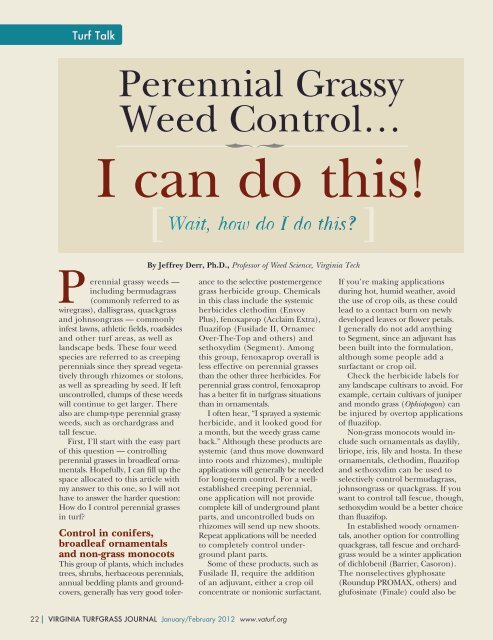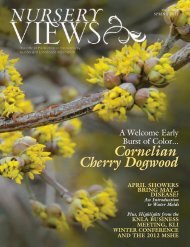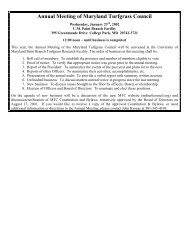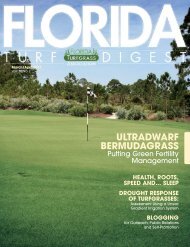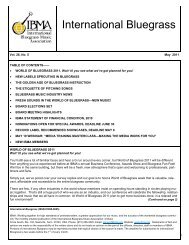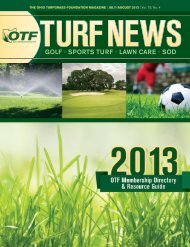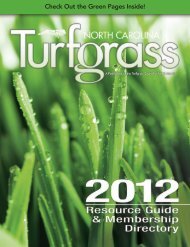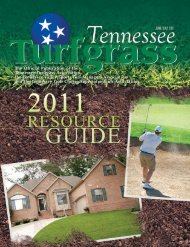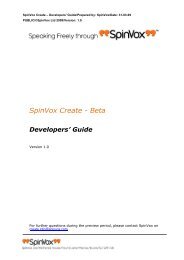Virginia Turfgrass Council / PO Box 5989 / Virginia Beach, VA 23471 ...
Virginia Turfgrass Council / PO Box 5989 / Virginia Beach, VA 23471 ...
Virginia Turfgrass Council / PO Box 5989 / Virginia Beach, VA 23471 ...
- No tags were found...
You also want an ePaper? Increase the reach of your titles
YUMPU automatically turns print PDFs into web optimized ePapers that Google loves.
Turf TalkPerennial grassy weeds —including bermudagrass(commonly referred to aswiregrass), dallisgrass, quackgrassand johnsongrass — commonlyinfest lawns, athletic fields, roadsidesand other turf areas, as well aslandscape beds. These four weedspecies are referred to as creepingperennials since they spread vegetativelythrough rhizomes or stolons,as well as spreading by seed. If leftuncontrolled, clumps of these weedswill continue to get larger. Therealso are clump-type perennial grassyweeds, such as orchardgrass andtall fescue.First, I’ll start with the easy partof this question — controllingperennial grasses in broadleaf ornamentals.Hopefully, I can fill up thespace allocated to this article withmy answer to this one, so I will nothave to answer the harder question:How do I control perennial grassesin turf?Control in conifers,broadleaf ornamentalsand non-grass monocotsThis group of plants, which includestrees, shrubs, herbaceous perennials,annual bedding plants and groundcovers,generally has very good toler-By Jeffrey Derr, Ph.D., Professor of Weed Science, <strong>Virginia</strong> Techance to the selective postemergencegrass herbicide group. Chemicalsin this class include the systemicherbicides clethodim (EnvoyPlus), fenoxaprop (Acclaim Extra),fluazifop (Fusilade II, OrnamecOver-The-Top and others) andsethoxydim (Segment). Amongthis group, fenoxaprop overall isless effective on perennial grassesthan the other three herbicides. Forperennial grass control, fenoxaprophas a better fit in turfgrass situationsthan in ornamentals.I often hear, “I sprayed a systemicherbicide, and it looked good fora month, but the weedy grass cameback.” Although these products aresystemic (and thus move downwardinto roots and rhizomes), multipleapplications will generally be neededfor long-term control. For a wellestablishedcreeping perennial,one application will not providecomplete kill of underground plantparts, and uncontrolled buds onrhizomes will send up new shoots.Repeat applications will be neededto completely control undergroundplant parts.Some of these products, such asFusilade II, require the additionof an adjuvant, either a crop oilconcentrate or nonionic surfactant.If you’re making applicationsduring hot, humid weather, avoidthe use of crop oils, as these couldlead to a contact burn on newlydeveloped leaves or flower petals.I generally do not add anythingto Segment, since an adjuvant hasbeen built into the formulation,although some people add asurfactant or crop oil.Check the herbicide labels forany landscape cultivars to avoid. Forexample, certain cultivars of juniperand mondo grass (Ophiopogon) canbe injured by overtop applicationsof fluazifop.Non-grass monocots would includesuch ornamentals as daylily,liriope, iris, lily and hosta. In theseornamentals, clethodim, fluazifopand sethoxydim can be used toselectively control bermudagrass,johnsongrass or quackgrass. If youwant to control tall fescue, though,sethoxydim would be a better choicethan fluazifop.In established woody ornamentals,another option for controllingquackgrass, tall fescue and orchardgrasswould be a winter applicationof dichlobenil (Barrier, Casoron).The nonselectives glyphosate(Roundup PROMAX, others) andglufosinate (Finale) could also be22| VIRGINIA TURFGRASS JOURNAL January/February 2012 www.vaturf.org


